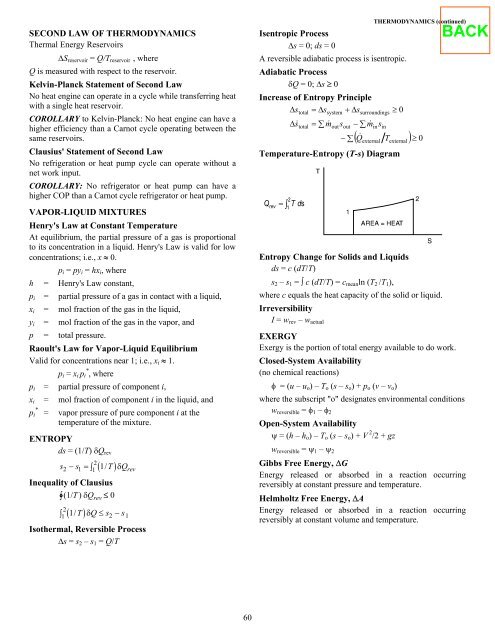fundamentals of engineering supplied-reference handbook - Ventech!
fundamentals of engineering supplied-reference handbook - Ventech!
fundamentals of engineering supplied-reference handbook - Ventech!
You also want an ePaper? Increase the reach of your titles
YUMPU automatically turns print PDFs into web optimized ePapers that Google loves.
SECOND LAW OF THERMODYNAMICS<br />
Thermal Energy Reservoirs<br />
∆Sreservoir = Q/Treservoir , where<br />
Q is measured with respect to the reservoir.<br />
Kelvin-Planck Statement <strong>of</strong> Second Law<br />
No heat engine can operate in a cycle while transferring heat<br />
with a single heat reservoir.<br />
COROLLARY to Kelvin-Planck: No heat engine can have a<br />
higher efficiency than a Carnot cycle operating between the<br />
same reservoirs.<br />
Clausius' Statement <strong>of</strong> Second Law<br />
No refrigeration or heat pump cycle can operate without a<br />
net work input.<br />
COROLLARY: No refrigerator or heat pump can have a<br />
higher COP than a Carnot cycle refrigerator or heat pump.<br />
VAPOR-LIQUID MIXTURES<br />
Henry's Law at Constant Temperature<br />
At equilibrium, the partial pressure <strong>of</strong> a gas is proportional<br />
to its concentration in a liquid. Henry's Law is valid for low<br />
concentrations; i.e., x ≈ 0.<br />
pi = pyi = hxi, where<br />
h = Henry's Law constant,<br />
pi = partial pressure <strong>of</strong> a gas in contact with a liquid,<br />
xi = mol fraction <strong>of</strong> the gas in the liquid,<br />
yi = mol fraction <strong>of</strong> the gas in the vapor, and<br />
p = total pressure.<br />
Raoult's Law for Vapor-Liquid Equilibrium<br />
Valid for concentrations near 1; i.e., xi ≈ 1.<br />
pi = xi pi * , where<br />
pi = partial pressure <strong>of</strong> component i,<br />
xi = mol fraction <strong>of</strong> component i in the liquid, and<br />
pi * = vapor pressure <strong>of</strong> pure component i at the<br />
temperature <strong>of</strong> the mixture.<br />
ENTROPY<br />
ds = (1/T) δQrev<br />
( )<br />
2<br />
2 1 1 1/ − = ∫ δ rev<br />
s s T Q<br />
Inequality <strong>of</strong> Clausius<br />
∫ (1/ T ) δQ<br />
≤ 0<br />
2<br />
1<br />
∫<br />
( )<br />
rev<br />
1/T δQ≤ s −s<br />
2 1<br />
Isothermal, Reversible Process<br />
∆s = s2 – s1 = Q/T<br />
60<br />
Isentropic Process<br />
∆s = 0; ds = 0<br />
A reversible adiabatic process is isentropic.<br />
Adiabatic Process<br />
δQ = 0; ∆s ≥ 0<br />
Increase <strong>of</strong> Entropy Principle<br />
∆stotal<br />
= ∆ssystem<br />
+ ∆ssurroundings<br />
≥ 0<br />
∆s�<br />
total = ∑m�outsout − ∑m�insin<br />
− ∑ Q�<br />
T ≥<br />
THERMODYNAMICS (continued)<br />
( )<br />
external<br />
external<br />
Temperature-Entropy (T-s) Diagram<br />
Q rev<br />
= ∫<br />
2<br />
T ds<br />
1<br />
Entropy Change for Solids and Liquids<br />
ds = c (dT/T)<br />
s2 – s1 = ∫ c (dT/T) = cmeanln (T2 /T1),<br />
where c equals the heat capacity <strong>of</strong> the solid or liquid.<br />
Irreversibility<br />
I = wrev – wactual<br />
EXERGY<br />
Exergy is the portion <strong>of</strong> total energy available to do work.<br />
Closed-System Availability<br />
(no chemical reactions)<br />
φ = (u – uo) – To (s – so) + po (v – vo)<br />
where the subscript "o" designates environmental conditions<br />
wreversible = φ1 – φ2<br />
Open-System Availability<br />
ψ = (h – ho) – To (s – so) + V 2 /2 + gz<br />
wreversible = ψ1 – ψ2<br />
Gibbs Free Energy, ∆G<br />
Energy released or absorbed in a reaction occurring<br />
reversibly at constant pressure and temperature.<br />
Helmholtz Free Energy, ∆A<br />
Energy released or absorbed in a reaction occurring<br />
reversibly at constant volume and temperature.<br />
0
















